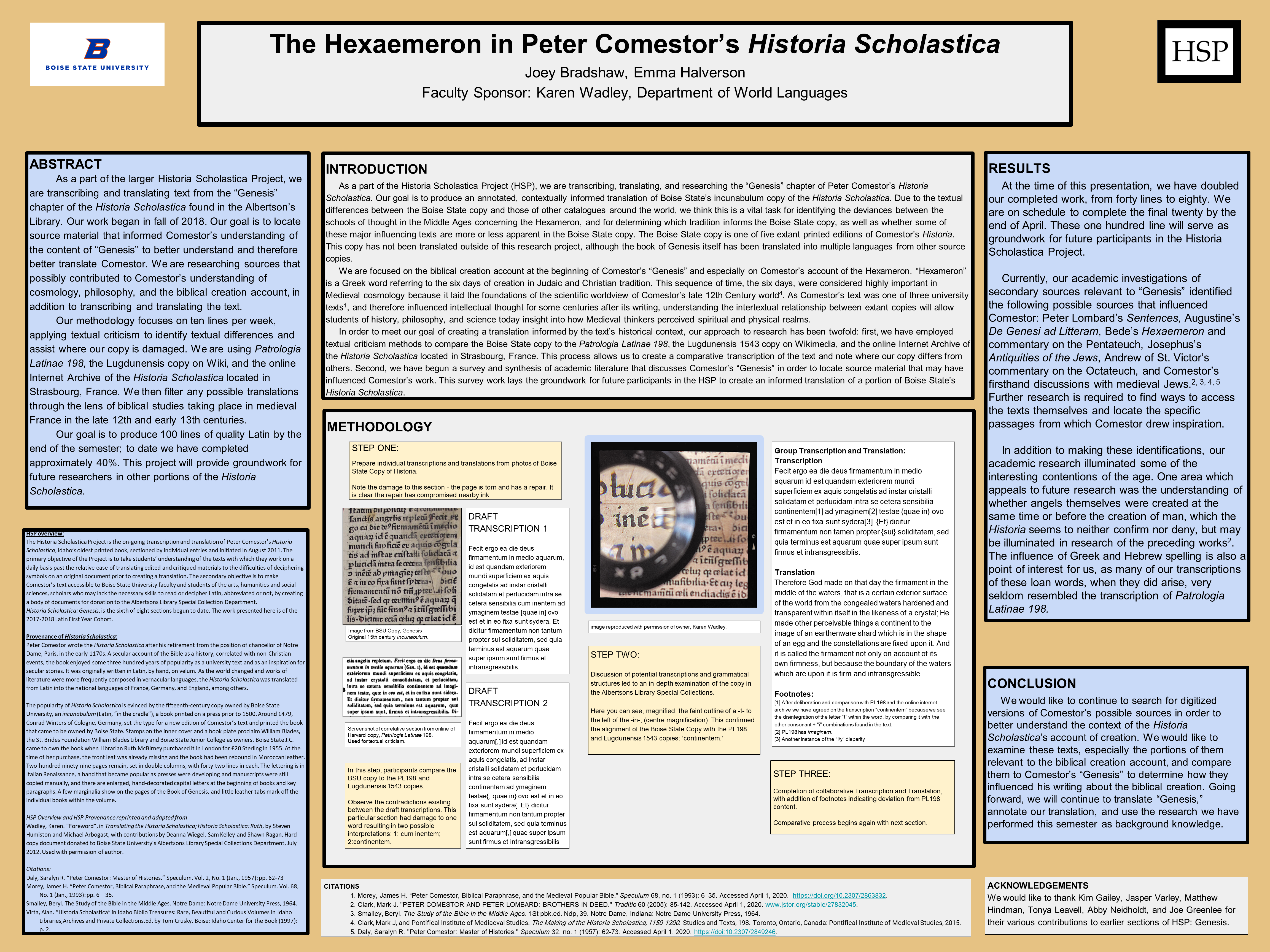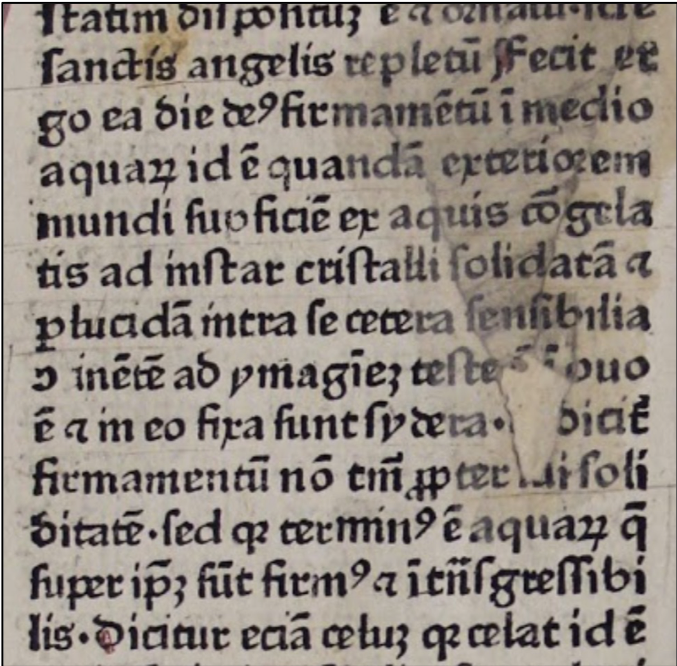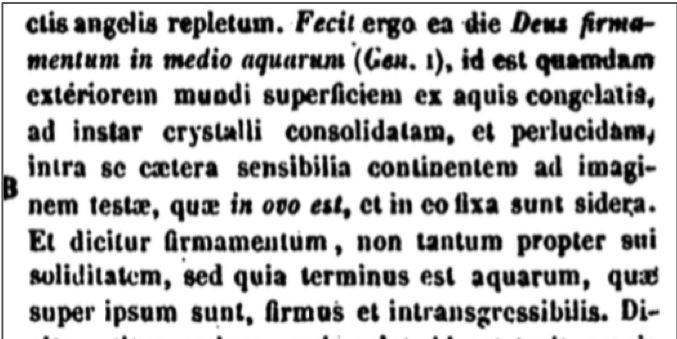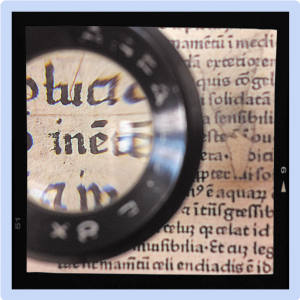
Joey Bradshaw, Emma Halverson, Karen Wadley
Abstract
As a part of the larger Historia Scholastica Project, we are transcribing and translating text from the “Genesis” chapter of the Historia Scholastica found in the Albertson’s Library. Our work began in fall of 2018. Our goal is to locate source material that informed Comestor’sunderstanding of the content of “Genesis” to better understand and therefore better translate Comestor. We are researching sources that possibly contributed to Comestor’sunderstanding of cosmology, philosophy, and the biblical creation account, in addition to transcribing and translating the text.
Our methodology focuses on ten lines per week, applying textual criticism to identify textual differences and assist where our copy is damaged. We are usingPatrologiaLatinae198, theLugdunensiscopy on Wiki, and the online Internet Archive of the Historia Scholasticalocated in Strasbourg, France. We then filter any possible translations through the lens of biblical studies taking place in medieval France in the late 12th and early 13th centuries.
Our goal is to produce 100 lines of quality Latin by the end of the semester; to date we have completed approximately 40%. This project will provide groundwork for future researchers in other portions of the Historia Scholastica.
Introduction
As a part of the Historia Scholastica Project (HSP), we are transcribing, translating, and researching the “Genesis” chapter of Peter Comestor’sHistoria Scholastica. Our goal is to produce an annotated, contextually informed translation of Boise State’s incunabulum copy of the Historia Scholastica. Due to the textual differences between the Boise State copy and those of other catalogues around the world, we think this is a vital task for identifying the deviances between the schools of thought in the Middle Ages concerning the Hexameron, and for determining which tradition informs the Boise State copy, as well as whether some of these major influencing texts are more or less apparent in the Boise State copy. The Boise State copy is one of five extant printed editions of Comestor’sHistoria. This copy has not been translated outside of this research project, although the book of Genesis itself has been translated into multiple languages from other source copies.
We are focused on the biblical creation account at the beginning of Comestor’s“Genesis” and especially on Comestor’saccount of the Hexameron. “Hexameron” is a Greek word referring to the six days of creation in Judaic and Christian tradition. This sequence of time, the six days, were considered highly important in Medieval cosmology because it laid the foundations of the scientific worldview of Comestor’slate 12th Century world4. As Comestor’stext was one of three university texts1, and therefore influenced intellectual thought for some centuries after its writing, understanding the intertextual relationship between extant copies will allow students of history, philosophy, and science today insight into how Medieval thinkers perceived spiritual and physical realms.
In order to meet our goal of creating a translation informed by the text’s historical context, our approach to research has been twofold: first, we have employed textual criticism methods to compare the Boise State copy to the PatrologiaLatinae198, the Lugdunensis1543 copy on Wikimedia, and the online Internet Archive of the Historia Scholasticalocated in Strasbourg, France. This process allows us to create a comparative transcription of the text and note where our copy differs from others. Second, we have begun a survey and synthesis of academic literature that discusses Comestor’s“Genesis” in order to locate source material that may have influenced Comestor’swork. This survey work lays the groundwork for future participants in the HSP to create an informed translation of a portion of Boise State’s Historia Scholastica.
HSP Overview
The Historia Scholastica Project is the on-going transcription and translation of Peter Comestor’sHistoria Scholastica, Idaho’s oldest printed book, sectioned by individual entries and initiated in August 2011. The primary objective of the Project is to take students’ understanding of the texts with which they work on a daily basis past the relative ease of translating edited and critiqued materials to the difficulties of deciphering symbols on an original document prior to creating a translation. The secondary objective is to make Comestor’stext accessible to Boise State University faculty and students of the arts, humanities and social sciences, scholars who may lack the necessary skills to read or decipher Latin, abbreviated or not, by creating a body of documents for donation to the Albertsons Library Special Collection Department.
Historia Scholastica: Genesis, is the sixth of eight sections begun to date. The work presented here is of the 2017-2018 Latin First Year Cohort.
Provenance of Historia Scholastica
Peter Comestorwrote the Historia Scholastica after his retirement from the position of chancellor of Notre Dame, Paris, in the early 1170s. A secular account of the Bible as a history, correlated with non-Christian events, the book enjoyed some three hundred years of popularity as a university text and as an inspiration for secular stories. It was originally written in Latin, by hand, on velum. As the world changed and works of literature were more frequently composed in vernacular languages, the Historia Scholasticawas translated from Latin into the national languages of France, Germany, and England, among others.
The popularity of Historia Scholasticais evinced by the fifteenth-century copy owned by Boise State University, an incunabulum(Latin, “in the cradle”), a book printed on a press prior to 1500. Around 1479, Conrad Winters of Cologne, Germany, set the type for a new edition of Comestor’stext and printed the book that came to be owned by Boise State. Stamps on the inner cover and a book plate proclaim William Blades, the St. Brides Foundation William Blades Library and Boise State Junior College as owners. Boise State J.C. came to own the book when Librarian Ruth McBirneypurchased it in London for ₤20 Sterling in 1955. At the time of her purchase, the front leaf was already missing and the book had been rebound in Moroccan leather. Two-hundred ninety-nine pages remain, set in double columns, with forty-two lines in each. The lettering is in Italian Renaissance, a hand that became popular as presses were developing and manuscripts were still copied manually, and there are enlarged, hand-decorated capital letters at the beginning of books and key paragraphs. A few marginalia show on the pages of the Book of Genesis, and little leather tabs mark off the individual books within the volume.
HSP Overview and HSP Provenance reprinted and adapted from
Wadley, Karen. “Foreword”, in Translating the Historia Scholastica; Historia Scholastica: Ruth, by Steven Humistonand Michael Arbogast, with contributions by Deanna Wiegel, Sam Kelley and Shawn Ragan. Hard-copy document donated to Boise State University’s Albertsons Library Special Collections Department, July 2012. Used with permission of author.
Citations
- Daly, Saralyn R. “Peter Comestor: Master of Histories.” Speculum. Vol. 2, No. 1 (Jan., 1957): pp. 62-73
- Morey, James H. “Peter Comestor, Biblical Paraphrase, and the Medieval Popular Bible.” Speculum. Vol. 68, No. 1 (Jan., 1993): pp. 6 – 35.
- Smalley, Beryl. The Study of the Bible in the Middle Ages. Notre Dame: Notre Dame University Press, 1964.
- Virta, Alan. “Historia Scholastica” in Idaho Biblio Treasures: Rare, Beautiful and Curious Volumes in Idaho Libraries,Archives and Private Collections.Ed. by Tom Crusky. Boise: Idaho Center for the Book (1997): p. 2.
Methodology
Step one:
Prepare individual transcriptions and translations from photos of Boise State Copy of Historia. Note the damage to this section – the page is torn and has a repair. It is clear the repair has compromised nearby ink.
In this step, participants compare the BSU copy to the PL198 and Lugdunensis1543 copies.
Observe the contradictions existing between the draft transcriptions. This particular section had damage to one word resulting in two possible interpretations: 1: cum inentem; 2:continentem.


Draft Transcription 1
“Fecit ergo ea die deus firmamentumin medio aquarum, id est quandam exteriorem mundi superficiemex aquiscongelatisad instar cristallisolidatamet perlucidamintra se cetera sensibiliacum inentemad ymaginem testae[quae in] ovoestet in eofixasuntsydera. Et diciturfirmamentumnon tantum propter sui soliditatem,sed quia terminus est aquarum quaesuper ipsum sunt firmus et intransgressibilis.”
Draft Transcription 2
“Fecit ergo ea die deus firmamentumin medio aquarum[,] id est quandam exteriorem mundi superficiem ex aquis congelatis, ad instar cristallisolidatamet perlucidam intra se cetera sensibilia continentem ad ymaginemtestae{,quaein} ovo est et in eo fixa sunt sydera{. Et} dicitur firmamentum non tantum propter sui soliditatem,sed quia terminus esta quarum[,]quae super ipsum sunt firmus et intransgressibilis
Step two:

Discussion of potential transcriptions and grammatical structures led to an in-depth examination of the copy in the Albertsons Library Special Collections.
Here you can see, magnified, the faint outline of a -t- to the left of the -in-, (centremagnification). This confirmed the alignment of the Boise State Copy with the PL198 and Lugdunensis1543 copies: ‘continentem.’
Step three:
Completion of collaborative Transcription and Translation, with addition of footnotes indicating deviation from PL198 content.
Comparative process begins again with next section.
Group Transcription and Translation:
Transcription:
Fecit ergo ea die deus firmamentum in medio aquarum id est quandam exteriorem mundi superficiem ex aquis congelatis ad instar cristalli solidatam et perlucidam intra se cetera sensibilia continentem[1] ad ymaginem[2]testae{quaein} ovo est et in eo fixa sunt sydera[3]. {Et} dicitur firmamentum non tamen propter {sui} soliditatem,sed quia terminus est aquarum quae super ipsum sunt firmuset intransgressiblis.
Translation:
Therefore God made on that day the firmament in the middle of the waters, that is a certain exterior surface of the world from the congealed waters hardened and transparent within itself in the likeness of a crystal; He made other perceivable things a continent to the image of an earthenware shard which is in the shape of an egg and the constellations are fixed upon it. And it is called the firmament not only on account of its own firmness, but because the boundary of the waters which are upon it is firm and intransgressible.
Footnotes:
[1] After deliberation and comparison with PL198 and the online internet archive we have agreed on the transcription “continentem” because we see the disintegration of the letter “t” within the word, by comparing it with the other consonant + “i” combinations found in the text.
[2] PL198 has imaginem.
[3] Another instance of the “i/y” disparity
Results
At the time of this presentation, we have doubled our completed work, from forty lines to eighty. We are on schedule to complete the final twenty by the end of April. These one hundred line will serve as groundwork for future participants in the Historia Scholastica Project.
Currently, our academic investigations of secondary sources relevant to “Genesis” identified the following possible sources that influenced Comestor: Peter Lombard’s Sentences, Augustine’sDeGenesiad Litteram, Bede’s Hexaemeronand commentary on the Pentateuch, Josephus’s Antiquities of the Jews, Andrew of St. Victor’s commentary on the Octateuch, and Comestor’sfirsthand discussions with medieval Jews.2, 3, 4, 5 Further research is required to find ways to access the texts themselves and locate the specific passages from which Comestordrew inspiration.
In addition to making these identifications, our academic research illuminated some of the interesting contentions of the age. One area which appeals to future research was the understanding of whether angels themselves were created at the same time or before the creation of man, which the Historia seems to neither confirm nor deny, but may be illuminated in research of the preceding works2. The influence of Greek and Hebrew spelling is also a point of interest for us, as many of our transcriptions of these loan words, when they did arise, very seldom resembled the transcription of PatrologiaLatinae198.
Conclusion
We would like to continue to search for digitized versions of Comestor’spossible sources in order to better understand the context of the Historia Scholastica’s account of creation. We would like to examine these texts, especially the portions of them relevant to the biblical creation account, and compare them toComestor’s“Genesis” to determine how they influenced his writing about the biblical creation. Going forward, we will continue to translate “Genesis,” annotate our translation, and use the research we have performed this semester as background knowledge.
Acknowledgements
We would like to thank Kim Gailey, Jasper Varley, Matthew Hindman, Tonya Leavell, Abby Neidholdt, and Joe Greenlee for their various contributions to earlier sections of HSP: Genesis.
Citations
- Morey, James H. “Peter Comestor, Biblical Paraphrase, and the Medieval Popular Bible.” Speculum 68, no. 1 (1993): 6–35. Accessed April 1, 2020. https://doi.org/10.2307/2863832.
- Clark, Mark J. “PETER COMESTOR AND PETER LOMBARD: BROTHERS IN DEED.” Traditio 60 (2005): 85-142. Accessed April 1, 2020. www.jstor.org/stable/27832045.
- Smalley, Beryl. The Study of the Bible in the Middle Ages. 1St pbk.ed. Ndp, 39. Notre Dame, Indiana: Notre Dame University Press, 1964.
- Clark, Mark J, and Pontifical Institute of Mediaeval Studies. The Making of the Historia Scholastica, 1150 1200. Studies and Texts, 198. Toronto, Ontario, Canada: Pontifical Institute of Medieval Studies, 2015.
- Daly, Saralyn R. “Peter Comestor: Master of Histories.” Speculum 32, no. 1 (1957): 62-73. Accessed April 1, 2020. https://doi:10.2307/2849246.
Additional Information
For questions or comments about this research, contact Joseph Bradshaw at josephbradshaw1@u.boisestate.edu.